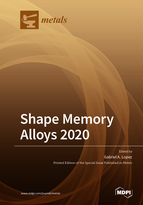Shape Memory Alloys 2020
A special issue of Metals (ISSN 2075-4701). This special issue belongs to the section "Corrosion and Protection".
Deadline for manuscript submissions: closed (30 April 2021) | Viewed by 28030
Special Issue Editor
Interests: shape memory alloys; advanced metallic materials; electron microscopy; infrared emissivity; alternative energy materials; phase transformations; diffraction
Special Issue Information
Dear Colleagues,
Shape memory alloys (SMAs), in comparison with other materials, have the exceptional ability to change their properties, structures, and functionality depending on the thermal, magnetic, and/or stress fields applied. This ability is based on the very characteristic displacive martensitic transformation from a high-temperature high-symmetry phase to a low-temperature low-symmetry martensite phase that takes place under certain conditions. In this Special Issue of Metals, we are interested in providing an overview of the latest developments of this type of materials, ranging from recent findings from a fundamental point of view, passing through the synthesis and processing methods and going up to the newest discoveries and potential applications in different fields.
As is well-known, in recent decades, the development of SMAs has allowed innovative solutions and alternatives in biomedical applications, advanced engineering structures for aerospace and automotive industries, as well as in sensor and actuation systems, among other sectors. Irrespective of this, designing and engineering using these special smart materials requires a solid background on materials science in order to consolidate their importance in these fields and to broaden their relevance in other new applications. Therefore, contributions on advances in synthesis and processing technologies, as well as new developments in these research fields, both from academic and applied researchers are welcome in this Special Issue.
Prof. Gabriel A. Lopez
Guest Editor
Manuscript Submission Information
Manuscripts should be submitted online at www.mdpi.com by registering and logging in to this website. Once you are registered, click here to go to the submission form. Manuscripts can be submitted until the deadline. All submissions that pass pre-check are peer-reviewed. Accepted papers will be published continuously in the journal (as soon as accepted) and will be listed together on the special issue website. Research articles, review articles as well as short communications are invited. For planned papers, a title and short abstract (about 100 words) can be sent to the Editorial Office for announcement on this website.
Submitted manuscripts should not have been published previously, nor be under consideration for publication elsewhere (except conference proceedings papers). All manuscripts are thoroughly refereed through a single-blind peer-review process. A guide for authors and other relevant information for submission of manuscripts is available on the Instructions for Authors page. Metals is an international peer-reviewed open access monthly journal published by MDPI.
Please visit the Instructions for Authors page before submitting a manuscript. The Article Processing Charge (APC) for publication in this open access journal is 2600 CHF (Swiss Francs). Submitted papers should be well formatted and use good English. Authors may use MDPI's English editing service prior to publication or during author revisions.
Keywords
- Fundamentals
- Advanced synthesis and manufacturing
- Simulation and modeling
- Advanced characterization
- From well-established SMAs to novel SMAs
- Biomedical shape memory alloys
- High-temperature shape memory alloys
- Magnetic shape memory alloys
- Applications
- Future challenges in the development of SMAs






